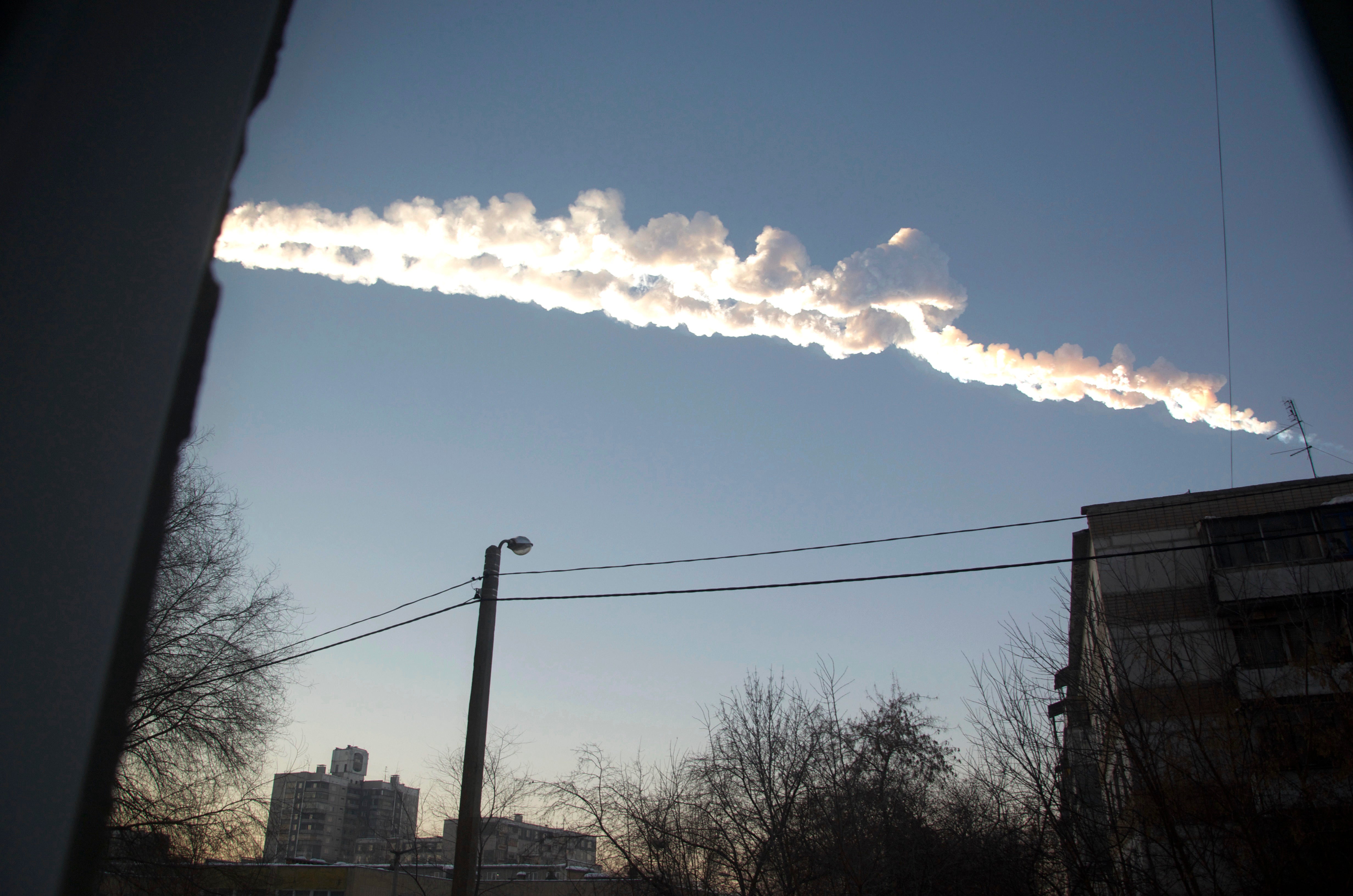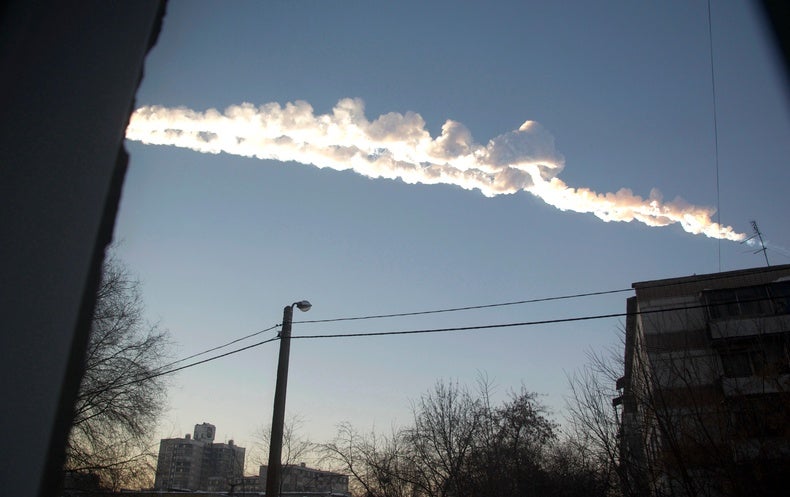
Ten years ago today, as the sun rose over Chelyabinsk, Russia, the sky exploded.
On February 15, 2013, an asteroid slammed into Earth’s atmosphere at nearly 70,000 kilometers per hour. Almost the size of a tennis court, it blazed brilliantly in the sky, as if a second sun had appeared and was racing from southeast to northwest.
Ramming through the air at hypersonic velocities blowtorched the asteroid’s surface, and left behind a thick trail of vaporized rock as it screamed over the Earth. The immense pressure started to flatten it (scientists call this “pancaking”) until the force finally overcame the asteroid some 40 kilometers above the ground. It crumbled into smaller chunks, each one still traveling over a dozen times the speed of a rifle bullet. These fragments themselves pancaked, creating a series of brief but powerful flashes of light as they heated to incandescence. Finally, the remaining pieces vaporized.
All of this happened in mere seconds, with the final blow occurring when the asteroid was about 30 kilometers up. The energy of its remaining motion was converted into heat in an instant. The resulting huge fireball briefly outshone the sun, emitting the equivalent energy of detonating half a million tons of TNT.
The shockwave from this explosion traveled away from the blast, taking nearly a minute to reach downtown Chelyabinsk, about 40 kilometers to the north. The industrial city of a million people was just starting its day when the apparition blazed across the sky. The awesome spectacle and the long, lingering vapor trail brought people outside or to their windows to see what happened—and that’s when the shock wave touched down.
A tremendous thunderclap shattered windows all over the city, the flying glass accounting for most of the roughly 1,500 people injured in the event. Fortunately, no one was killed, and infrastructure damage was relatively minimal. Had the asteroid been bigger, or made of metal, or plunged downward at a steeper angle, this story could have been quite different, the aftermath far more severe.
Chelyabinsk was a wake-up alarm for Earth. A loud one.
It was also a massive learning experience for scientists, the largest atmospheric impact since the Tunguska bolide in 1908. The asteroid’s smoking trail was viewed by satellites as well as by thousands of eyewitnesses and cameras, and matched with each explosive event. Meteorites rained widely, including one monster half-ton chunk nearly a meter across that plunged into a lake, and was later recovered. There’s even security camera footage of that piece as it impacted the frozen lake (and created a dramatic plume of snow and water shooting up into the air).
The meteorites recovered from the event revealed the asteroid’s violent history. Shock veins riddled them, leaving narrow fissures. These showed that the 19-meter-wide Chelyabinsk rock was once part of a much larger asteroid that itself had suffered an impact, which broke off the piece that hit Earth and cracked it throughout. Radioactive dating indicated that first impact may have occurred as long as 4.4 billion years ago, when the solar system itself was less than 200 million years old. Those fissures in the Chelyabinsk rock weakened it, allowing it to more easily disintegrate high above the ground and create that massive shock wave. The ghostly fingers of an ancient deep space impact had reached out and touched the lives of thousands of Russian people that day.
It’s not clear which asteroid may have been that parent asteroid. Scientists traced the trajectory of the Chelyabinsk impactor backward into space and found consistent matches to the asteroids 2007 BD7 and 2011 EO40. One may be the parent body, but this remains uncertain.
An analysis of Chelyabinsk together with smaller, lower-energy events showed that impactors like these hit us much more frequently than previously thought. A Chelyabinsk-sized impact happens every 25 years or so, statistically speaking, with most occurring over the ocean or wilderness areas, thankfully.
It’s a bit alarming that astronomers didn’t see this asteroid coming long before it hit us. But asteroids tend to be very dark, and small ones are extremely faint even when close to our planet. Just a few years earlier, the four-meter-wide asteroid 2008 TC3 was the first one ever detected before hitting Earth; only six others have been discovered before impact since, including 2023 CX1 that just lit up the English Channel on February 13, 2023, as if marking the week’s anniversary. All were small, posing no danger to us on the ground.
Now, after I’ve terrified you about impacts, comes the good news: we’re getting much better at finding them. In the decade since Chelyabinsk, about 20,000 near-Earth asteroids have been discovered: more than had been found in all of history up to 2013. New survey telescopes like Pan-STARRS and the Zwicky Transient Facility have come online, and better detection and analysis techniques have been developed that accelerated the rate of discovery. Soon the huge Vera Rubin Observatory and NASA’s NEO Surveyor space mission will also tremendously boost the number of known Earth-threatening asteroids.
Finding them, though, is just the first step. Doing something about them is the next. To that end, last September NASA launched the Double Asteroid Redirection Test (DART) mission, which slammed a half-ton impactor into the 170-meter-wide asteroid Dimorphos—a moon of the larger asteroid Didymos. The momentum from the collision changed the orbital period of the asteroid by over half an hour. That was even more than what was predicted—a vast plume of material that the impact excavated and flung away from the asteroid’s surface added a kick—showing that it’s possible to use such a spacecraft to alter an asteroid’s trajectory.
Bigger blasts might be able to divert an incoming space rock as well. Detonating a nuclear weapon near a small asteroid could vaporize much of its surface. This hot vapor would rapidly expand, acting like rocket exhaust and pushing the asteroid into a new and hopefully safer trajectory. There are some fairly difficult-to-overcome issues with this method—it’s currently illegal under the Outer Space Treaty to explode nuclear devices in space, for example—but a dangerous asteroid headed our way might grease the skids a bit on a political fix.
Since the Chelyabinsk impact, two spacecraft have not only approached small asteroids but also collected samples from them (one, Hyabusa 2, already dropped off its samples back at Earth, and the other, OSIRIS-Rex, will do so later this year). Both asteroids, Ryugu (roughly one kilometer across) and Bennu (500 meters across) are rubble piles, essentially loose collections of small rocks held together by their own meager gravity. It’s likely all small asteroids are rubble piles, which will affect how we might have to fend them off; their weak structures mean they can absorb the impact of a spacecraft more easily. Imagine trying to punch a box of packing peanuts and you get the idea. However, the DART mission also showed that huge amounts of material are ejected by an impact, and that transfer of momentum can actually increase the effect of an impact.
Chelyabinsk caught us by surprise, and though such small impacts may still sneak past our guard, we’re getting better at finding potential threats from space, and learning what we can do in case we find one with Earth in its crosshairs. Big, dangerous asteroids are rare, yet we need only look to Meteor Crater, Arizona, to see why we need to take them seriously. The 10-megaton explosion from that impact carved a hole over a kilometer across in the desert about 50,000 years ago, likely devastating the plants and animals living there at the time. This may be one of the most recent large direct impacts the earth has suffered, but it won’t be the last.
Unless, of course, we do something to stop them.
This is an opinion and analysis article, and the views expressed by the author or authors are not necessarily those of Scientific American.

